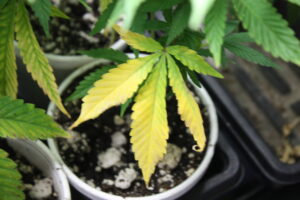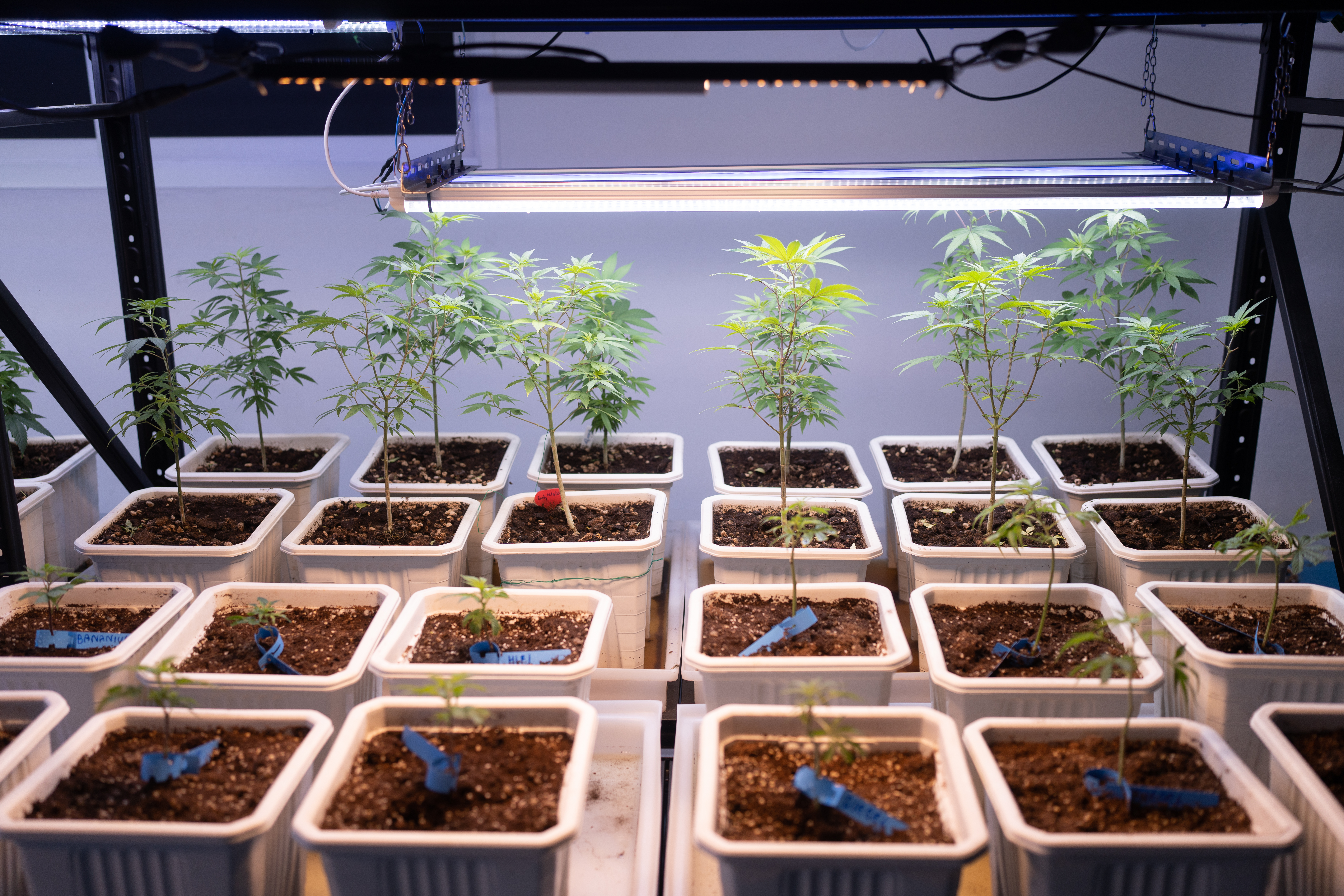
Your guide to crafting the perfect cannabis grow space is comprehensive, detailed, and thoughtfully organized. It offers a holistic view of what it takes to create an environment where cannabis plants can thrive, from choosing the right location to maintaining optimal growing conditions and ensuring privacy. This guide serves both beginners and experienced cultivators alike, providing valuable insights into the art and science of growing cannabis. It emphasizes the importance of careful planning, routine monitoring, and adapting to the plants’ needs, encapsulating the essence of successful cannabis cultivation.
Table of Contents

Location, Location, Location
Choosing the right location and effectively utilizing your available space are foundational steps in setting up a successful cannabis grow. These elements dictate not only the potential size and yield of your cannabis plants but also the methods and equipment you’ll need to manage them effectively. Let’s delve deeper into the considerations for selecting and optimizing your grow location and space.
1. Indoor vs. Outdoor Growing
Indoor Growing:
- Control: Indoor environments offer unparalleled control over growing conditions, including light, temperature, humidity, and CO2 levels. This control can lead to higher quality cannabis and the ability to harvest multiple times a year.
- Security and Privacy: Growing indoors provides more privacy and security, protecting your plants from theft, pests, and inclement weather.
- Space Requirements: Indoor growing typically requires less space than outdoor growing but demands more intensive management and higher initial setup costs for lights, ventilation, and climate control systems.
Outdoor Growing:
- Natural Resources: Utilizing the sun, rain, and natural soil reduces operational costs significantly. The natural light spectrum and environmental conditions can contribute to the development of complex cannabinoid and terpene profiles.
- Space and Yield: Outdoor plants can grow to their full potential, often resulting in larger yields per plant compared to indoor setups. However, you are limited to the growing season and must contend with the unpredictability of weather and outdoor pests.
- Legal and Social Considerations: Ensure that your outdoor grow complies with local laws and regulations. Outdoor grows can attract attention, so consider the visibility of your grow space and the potential impact on neighbors.
2. Maximizing Your Grow Space
Indoor Space Optimization:
- Vertical Farming: Utilize vertical space to increase your grow area. This approach requires careful planning regarding light distribution and air circulation but can significantly increase yield in limited spaces.
- Reflective Walls: Use reflective materials on the walls, ceiling, and even floors to ensure that your plants receive light from all angles, promoting even growth and maximizing light efficiency.
- Modular Systems: Consider modular grow systems that can be easily adjusted as plants grow or as you scale your operation. Flexibility in your setup allows for more efficient use of space and resources.
Outdoor Space Consideration:
- Companion Planting: Grow companion plants alongside your cannabis to deter pests and improve soil health. This method can also help camouflage your cannabis plants if privacy is a concern.
- Microclimate Management: Understand and leverage the microclimates within your garden. Planting in areas that receive optimal sunlight, wind protection, and moisture can improve plant health and yield.
- Space Planning: Allow sufficient space between plants to enable adequate airflow and sunlight penetration, reducing the risk of mold and pest infestations. Consider the mature size of your plants when planning your garden layout.
Environmental Impact and Sustainability
Whether growing indoors or outdoors, consider the environmental impact of your cultivation practices. Using renewable energy sources, water conservation techniques, and organic growing methods can reduce your carbon footprint and contribute to a more sustainable cannabis cultivation practice.
By carefully selecting your grow location and thoughtfully planning your use of space, you can create an efficient and productive environment that supports the health and yield of your cannabis plants. Each grow space is unique, and success comes from adapting your practices to your specific situation and continuously learning from each grow cycle.
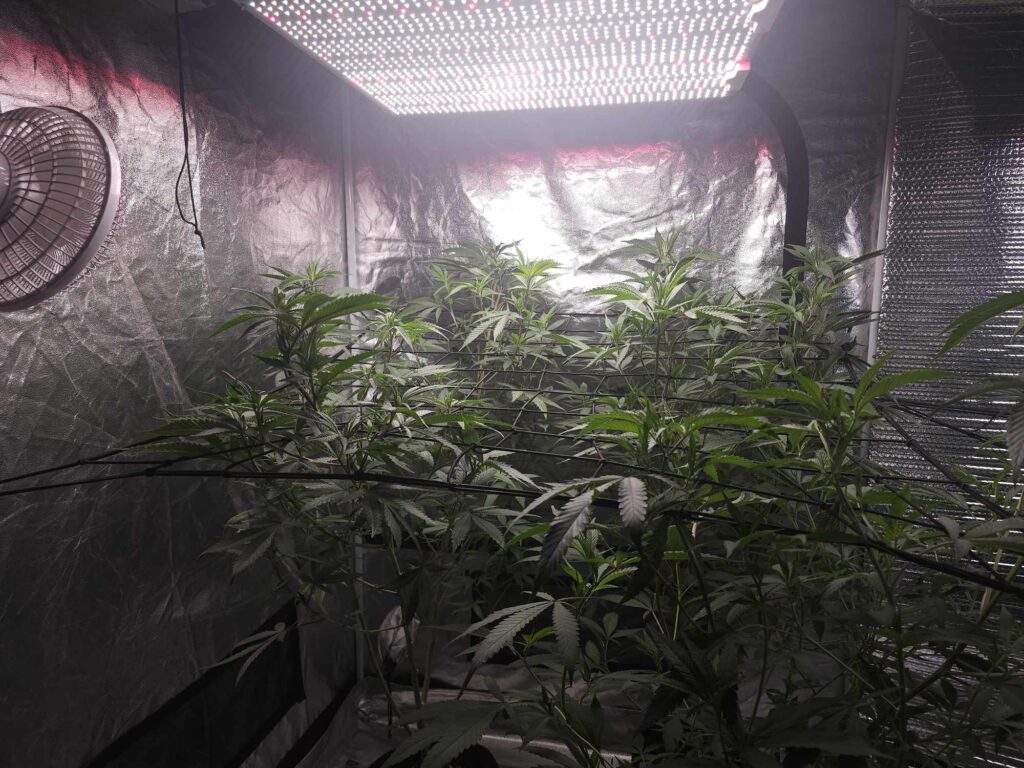
Let There Be Light…For Plants
Growing cannabis successfully indoors necessitates an understanding of the various grow light technologies available, each with its distinct advantages. Here, we delve into three popular types of grow lights: LED (Light Emitting Diodes), HPS (High-Pressure Sodium), and MH (Metal Halide) lamps, exploring how they cater to the needs of cannabis cultivation.
1. LED Lights: The Energy Efficient Choice
- Efficiency and Longevity: LED lights are celebrated for their energy efficiency and long lifespan. They consume less electricity and produce less heat compared to HPS and MH lamps, making them cost-effective in the long run.
- Full Spectrum: Modern LED grow lights offer a full spectrum of light, mimicking the natural sunlight. This spectrum is crucial for the different stages of plant growth, from vegetative growth to flowering.
- Cool Operation: The cool nature of LED lights reduces the need for extensive cooling systems in the grow room, minimizing the risk of heat stress on the plants.
2. HPS Lamps: The Intensity for Flowering
- High Output: HPS lamps are known for their high lumen output, providing intense light that penetrates deep into the canopy of the plants. This makes them particularly effective during the flowering stage, encouraging dense bud development.
- Warm Light Spectrum: The warm light spectrum of HPS lamps, rich in red and orange wavelengths, is ideal for the flowering phase, stimulating bud growth and development.
- Cost-Effective Setup: While HPS systems can be more expensive to operate due to their energy consumption and heat production, they remain a popular choice for their proven effectiveness in producing high yields.
3. MH Lamps: The Vegetative Growth Champion
- Blue Spectrum: MH lamps emit a light spectrum that’s rich in blue wavelengths, promoting strong vegetative growth. This spectrum is crucial for developing a robust structure and healthy foliage in the early stages of plant growth.
- Compatibility: MH lamps can often be used in the same fixtures as HPS lamps, allowing growers to switch between the two types depending on the growth stage of their plants, although this requires careful management of the growing environment to mitigate the heat produced.
Choosing the Right Light
Selecting the appropriate grow light technology depends on various factors, including the size of the grow space, the growth stage of the plants, energy efficiency considerations, and budget constraints. A mixed approach, using LED lights for their full spectrum and energy efficiency, supplemented by HPS or MH lamps at specific growth stages, can offer a balanced solution for optimal plant growth and yield.
By understanding the benefits and applications of these grow light technologies, cultivators can make informed decisions that align with their cultivation goals, ensuring a successful and productive grow space.

Advanced Climate Control Techniques for Optimizing Yield
Creating the perfect climate for cannabis cultivation is essential for maximizing yield and ensuring the health of your plants. Advanced climate control techniques go beyond basic temperature and humidity adjustments, incorporating a holistic approach to environmental management. Here, we explore several strategies that can significantly impact the productivity and quality of your cannabis grow space.
1. Automated Environmental Control Systems
- Precision and Consistency: Utilizing automated systems for controlling temperature, humidity, CO2 levels, and light exposure allows for precise adjustments tailored to the growth stage of your plants. Automation ensures consistency, which is critical for optimal plant development.
- Remote Monitoring: Many advanced systems offer remote monitoring capabilities, enabling growers to keep an eye on their grow space conditions from anywhere, making adjustments as needed to maintain the ideal environment.
2. CO2 Enrichment
- Boosting Photosynthesis: Introducing additional CO2 into the grow space can dramatically increase the rate of photosynthesis, leading to faster growth and potentially higher yields, provided that light, water, and nutrient levels are also optimized.
- Controlled Release: Advanced CO2 systems allow for the controlled release of CO2, maintaining optimal levels for plant absorption without wasting resources. Safety measures must be in place to prevent CO2 levels from becoming harmful to both plants and humans.
3. Precision Humidity Control
- Vapor Pressure Deficit (VPD): Understanding and managing VPD—a measure of the difference between the amount of moisture in the air and how much moisture the air can hold at a given temperature—can significantly impact plant health and yield. Optimizing VPD helps ensure that plants transpire effectively, promoting nutrient uptake and robust growth.
- Dehumidifiers and Humidifiers: Advanced climate control involves the use of dehumidifiers and humidifiers not just to maintain general humidity levels but to adjust them precisely according to the plant’s growth stage and the current VPD.
4. Temperature Zoning
- Microclimates Within the Grow Space: Creating different temperature zones within a single grow space can cater to the specific needs of plants at different growth stages. This technique requires sophisticated environmental control systems capable of managing these microclimates efficiently.
5. Integrated Pest Management (IPM)
- Climate as a Pest Control Tool: Part of advanced climate control includes using temperature and humidity adjustments as a method for pest and disease management. Certain pests and diseases thrive under specific conditions, so adjusting the environment can make the grow space less hospitable for these unwelcome guests.
Implementing Advanced Climate Control
While advanced climate control techniques offer the potential for significantly improved yields and healthier plants, they also require a higher initial investment in technology and a deeper understanding of plant physiology. The benefits, however, from reduced resource waste to higher quality harvests, can outweigh the costs for serious cultivators looking to optimize their grow operations.
Adopting a holistic approach to climate control, considering factors like CO2 levels, and VPD, and creating microclimates, can elevate your cannabis cultivation to professional standards, leading to exceptional results in both yield and quality.
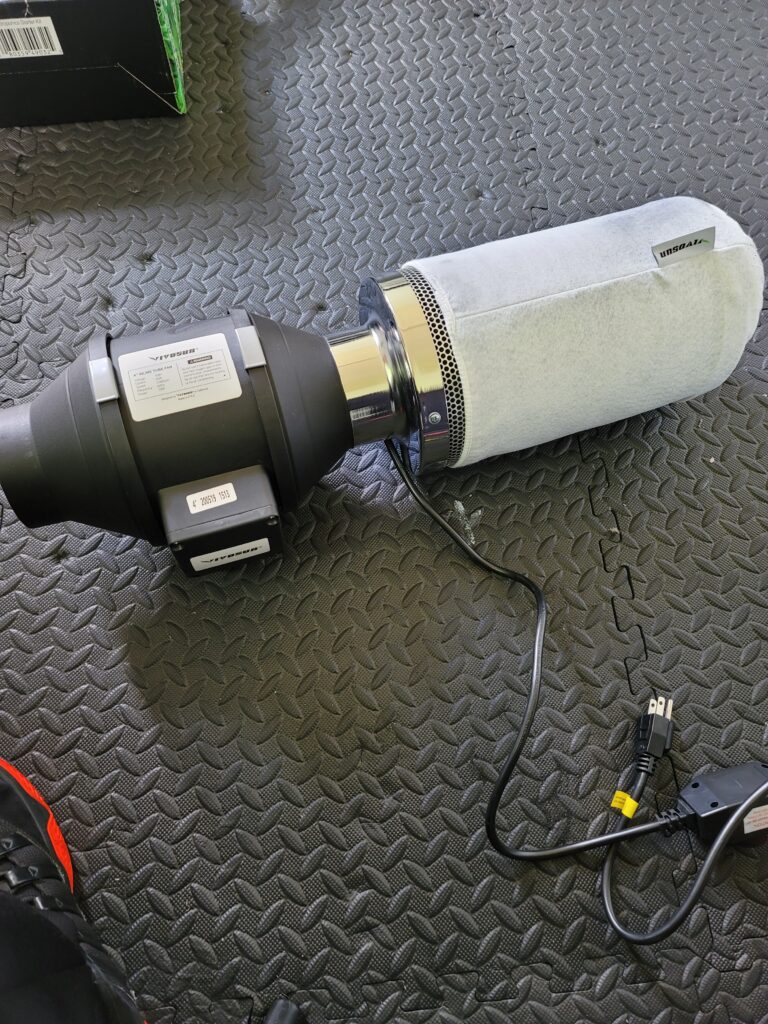
The Importance of Ventilation and Keeping the Loud Quiet
Ventilation, air circulation, and the management of sound and smell are critical components of a successful and discreet cannabis grow operation. Proper attention to these elements ensures the health of your plants, maximizes efficiency, and minimizes the impact of your grow on the surrounding environment. Let’s explore each of these aspects in more detail.
1. Ventilation and Air Circulation
Importance for Plant Health
- Gas Exchange: Plants require CO2 for photosynthesis. Proper ventilation ensures a constant supply of CO2, enhancing growth and productivity.
- Temperature and Humidity Control: Effective ventilation systems help maintain optimal temperature and humidity levels, crucial for preventing mold, mildew, and pests.
Setting Up Effective Ventilation
- Exhaust Systems: An exhaust fan, ideally located at the top of your grow space, expels warm, stale air, which is naturally more buoyant. The size and capacity of the fan should match your grow space volume and heat load generated by your grow lights.
- Intake Systems: Passive or active intake systems bring fresh, cool air into the grow space. Ensure that the intake area is smaller than the exhaust area to maintain negative pressure, which helps control odor and pathogens.
Optimizing Air Circulation
- Oscillating Fans: Use oscillating fans to create a gentle breeze that strengthens plant stems and mimics the natural movement of air. This also helps evenly distribute CO2 and reduces hot spots in the grow area.
- Strategic Placement: Position fans to avoid direct airflow on plants, which can cause windburn. Instead, aim for a uniform circulation that reaches all parts of the plant canopy.
2. Managing Sound
Noise Sources
- Fans and Air Systems: The primary sources of noise in a grow room are ventilation fans and air conditioning units.
- Water Pumps: In hydroponic setups, water pumps can also generate noise.
Soundproofing Techniques
- Insulation: Use sound-absorbing materials like foam or fiberglass insulation around the grow room walls and on ducting to reduce noise transmission.
- Quieter Equipment: Invest in high-quality, quiet fans and water pumps designed for low noise output.
- Vibration Dampeners: Install vibration dampeners or mounts on fans and air systems to reduce the transmission of vibration and associated noise.
3. Controlling Smell
Odor Sources
- Flowering Cannabis Plants: Cannabis plants, especially during the flowering stage, produce strong odors that can be detectable outside your grow space.
Odor Control Strategies
- Carbon Filters: Install a high-quality carbon filter in your exhaust system to scrub the air of odors before it’s vented outside. Carbon filters are highly effective at neutralizing cannabis smells.
- Sealing the Grow Space: Ensure your grow space is well-sealed, with no unfiltered air leaks, to prevent odor escape.
- Negative Pressure: Maintaining slight negative pressure within the grow room helps keep odors contained within the space, preventing them from leaking out.
Integrating These Systems
Successfully integrating ventilation, air circulation, sound management, and odor control requires careful planning and consideration of your specific grow space and needs. The goal is to create a sustainable, efficient environment that supports the health of your plants while minimizing its impact on your living space and the broader environment. Through strategic investment in the right equipment and thoughtful implementation of these systems, you can achieve a discreet, productive, and enjoyable cannabis cultivation experience.

Medium Matters
Exploring different growing mediums and nutrient types is essential for optimizing cannabis growth and yields. Each medium has its unique characteristics and requirements, which influence the choice of nutrients and how they are delivered to the plant. Let’s delve into the most commonly used growing mediums in cannabis cultivation and the types of nutrients that best complement them.
Growing Mediums
1. Soil
- Characteristics: Soil is the most traditional growing medium, valued for its buffering capacity, which can forgive many small mistakes by the grower. It contains organic matter and microorganisms beneficial to plant growth.
- Nutrients: Organic nutrients are often preferred for soil grows to enhance its natural microbiome. Slow-release fertilizers can be mixed into the soil before planting, and liquid organic nutrients can be added during watering for additional feeding.
2. Coco Coir
- Characteristics: Made from the fibrous husks of coconut shells, coco coir is an inert medium that provides excellent aeration and moisture retention. It requires regular fertilization as it does not contain nutrients.
- Nutrients: Coco-specific nutrient formulas are necessary, as coco coir can bind to certain elements, making them unavailable to plants. These formulas often contain elevated levels of calcium and magnesium.
3. Hydroponics
- Characteristics: Hydroponic systems grow plants in a water-based, nutrient-rich solution without soil. These systems allow for precise control over nutrients and pH levels but require careful monitoring and maintenance.
- Nutrients: Hydroponic nutrients are available in liquid form and are immediately available to the plant roots. They must be complete and balanced, providing all the essential macro and micronutrients in the correct ratios.
4. Aeroponics
- Characteristics: Aeroponics involves growing plants in an air or mist environment without the use of soil or an aggregate medium. The roots hang in the air and are periodically misted with a nutrient solution.
- Nutrients: Similar to hydroponics, aeroponics uses a water-soluble, complete nutrient solution that is sprayed directly onto the roots.
5. Perlite and Vermiculite
- Characteristics: Perlite and vermiculite are used to improve soil aeration and water retention. They can be mixed with soil or used in hydroponic setups but do not provide nutrients on their own.
- Nutrients: Plants grown in these amendments require regular feeding with a balanced nutrient solution, similar to hydroponic nutrients.
Nutrient Types
Macro and Micronutrients
- Macronutrients: Nitrogen (N), Phosphorus (P), and Potassium (K) are the primary nutrients required in larger amounts. They are crucial for vegetative growth, root development, and flowering.
- Micronutrients: Elements like Calcium (Ca), Magnesium (Mg), and Iron (Fe) are needed in smaller quantities but are essential for plant health and disease resistance.
Organic vs. Synthetic Nutrients
- Organic Nutrients: Derived from natural sources, organic nutrients improve soil health and contribute to the overall ecosystem of the grow medium. They are released more slowly and can enhance the taste and aroma of cannabis.
- Synthetic Nutrients: These are chemically formulated to be immediately available to plants. They allow for precise control over nutrient ratios but require careful management to avoid nutrient burn.
Water-soluble vs. Slow-Release Fertilizers
- Water-soluble fertilizers: These are quickly absorbed by plants and are ideal for providing immediate nutrient boosts or correcting deficiencies.
- Slow-Release Fertilizers: Encapsulated to dissolve over time, slow-release fertilizers provide a steady supply of nutrients, reducing the need for frequent feeding.
Selecting the right medium and nutrient type for your cannabis cultivation depends on various factors, including your cultivation setup, experience level, and the specific needs of your cannabis strain. Understanding the properties of each medium and how they interact with different nutrient types is crucial for creating an optimal growing environment that supports healthy plant growth and maximizes yields. Here’s a deeper dive into mediums to check out later!
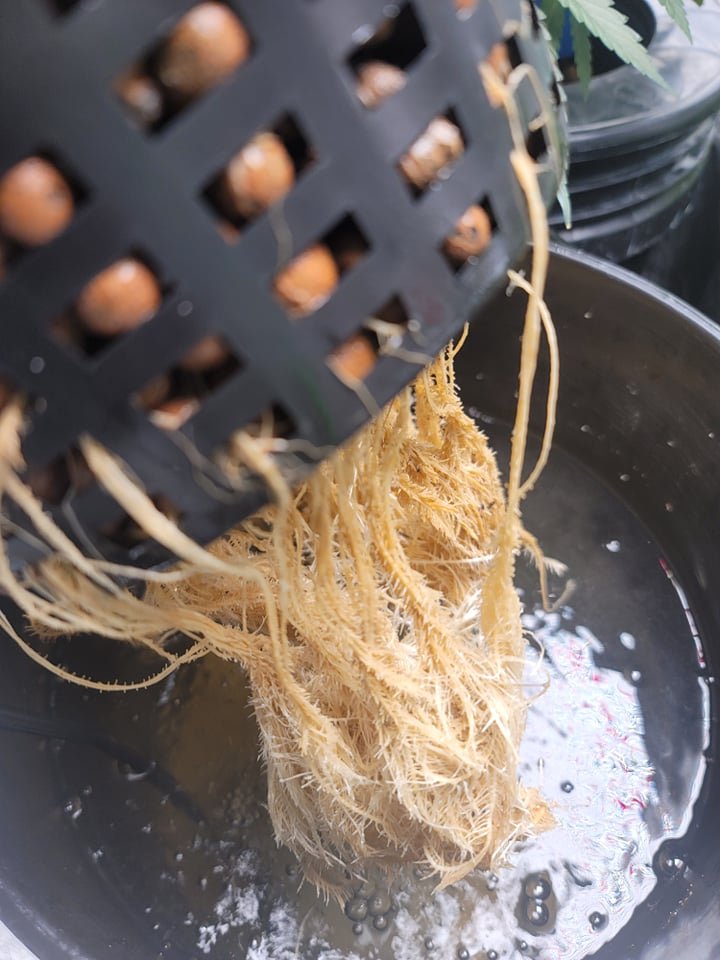
Dive into Soil versus Hydroponic Systems
Choosing the right medium for growing cannabis is crucial for the health and yield of your plants. Both soil and hydroponic systems offer unique benefits and challenges. Understanding these nuances can help you make an informed decision that aligns with your cultivation goals, resources, and level of expertise.
1. Soil-Based Systems: The Natural Approach
- Ease of Use: Soil is often favored by beginners and those looking for a more natural approach to cultivation. It’s more forgiving of mistakes, such as overwatering or nutrient imbalances.
- Buffering Capacity: Soil has a natural buffering capacity, meaning it can absorb and gradually release nutrients to the plants, reducing the risk of nutrient burn.
- Flavor and Aroma: Many cultivators believe that soil-grown cannabis offers superior flavors and aromas due to the complex interactions between the roots, soil, and microbial life, which can contribute to the terpene profile of the cannabis.
2. Hydroponic Systems: The Precision Approach
- Faster Growth and Higher Yields: Hydroponic systems typically produce faster growth rates and higher yields compared to soil, as they allow direct control over nutrient delivery and oxygen to the roots.
- Efficient Resource Use: These systems use water and nutrients more efficiently, which can be especially beneficial in areas with limited water resources.
- Requires Monitoring and Expertise: Hydroponics requires a more hands-on approach and a good understanding of plant nutrition and water chemistry. pH and nutrient levels must be monitored and adjusted frequently to maintain optimal growing conditions.
Comparing Key Factors
| Factor | Soil | Hydroponics |
|---|---|---|
| Ease of Use | More forgiving; suitable for beginners. | Requires more knowledge and attention. |
| Growth Speed | Slower compared to hydroponics. | Faster growth rates. |
| Yield | Generally lower than hydroponics. | Potential for higher yields. |
| Resource Use | Less efficient use of water and nutrients. | More efficient use of water and nutrients. |
| Flavor/Aroma | Often considered superior due to soil microbes. | Can be excellent but may lack soil’s complexity. |
| Environmental | More sustainable but depends on soil management | Less waste but requires energy for systems. |
Choosing the Right Medium for Your Grow
The choice between soil and hydroponics comes down to personal preference, resource availability, and your commitment level. If you’re new to cannabis cultivation, starting with soil might be less intimidating. However, if you’re ready to dive into a more hands-on, technical growing experience with the potential for higher yields, hydroponics could be the right path for you.
Both systems have the potential to produce high-quality cannabis, but the approach to management, the environmental impact, and the final product’s characteristics can differ significantly. By considering these nuances, you can tailor your cultivation practice to meet your specific goals, whether they lean towards sustainability, yield, potency, or flavor.
The Setup: Efficiency Is Key
A well-organized grow room is not just a productive space; it’s a cornerstone of successful cannabis cultivation. The heart of this organization often lies in the efficiency and effectiveness of a grow tent setup. For enthusiasts and professionals alike, crafting an optimal environment within a grow tent can significantly enhance the quality and yield of cannabis plants. Let’s explore key considerations for maximizing the efficiency of a grow tent setup and conclude with actionable advice for cannabis cultivators.

Grow Tent Setup: Maximizing Efficiency
1. Choosing the Right Size
- Space Evaluation: Begin by assessing the available space and determining how many plants you intend to grow. A common mistake is underestimating the space required for mature plants and their care, leading to overcrowded and unhealthy conditions.
- Headroom for Growth: Ensure there’s adequate height for not only the plants but also the lighting system, ventilation equipment, and potential vertical growth.
2. Lighting Solutions
- Optimal Lighting: Select a lighting system that matches the size of your tent and the needs of your plants. LED lights are favored for their efficiency, spectrum range, and low heat output, minimizing the risk of heat stress.
- Even Distribution: Arrange lights to cover the canopy evenly, ensuring all plants receive sufficient light, vital for consistent growth and development.
3. Ventilation and Air Circulation
- Fresh Air Exchange: Install an effective ventilation system to control temperature and humidity. An exhaust fan at the top and an intake fan at the bottom of the tent help maintain a steady flow of air.
- Oscillating Fans: Inside the tent, use oscillating fans to promote air circulation, strengthening plant stems and preventing mold and mildew.
4. Climate Control
- Temperature and Humidity Monitoring: Equip your tent with a reliable thermometer and hygrometer to keep track of the environmental conditions. Adjustments might be necessary to maintain the ideal temperature (68°F to 77°F) and humidity levels (40-60% RH for vegetative stage, lowering in flowering stage).
5. Space Utilization
- Vertical Space: Utilize vertical space efficiently by installing shelves or hanging systems for smaller plants or equipment, maximizing the grow area.
- Organized Layout: Plan your layout to ensure easy access to all plants for maintenance, watering, and monitoring without disturbing their neighbors.
6. Cleanliness and Maintenance
- Regular Cleaning: A clean grow tent is essential for preventing pests and diseases. Remove debris and disinfect surfaces regularly to maintain a sterile environment.
- Routine Checks: Inspect your setup regularly for any signs of stress on the plants, malfunctioning equipment, or environmental fluctuations that need correction.
Conclusion: A Guide for Cultivators
Setting up an efficient grow tent involves carefully balancing space, lighting, ventilation, and environmental control to create optimal conditions for cannabis cultivation. By selecting the right equipment and maintaining a clean, well-monitored environment, you can foster healthy and productive plants.
Success in cannabis cultivation hinges on attention to detail. The setup of your grow tent directly impacts plant health and yield. Focus on organization, monitoring, and adaptability. Embrace the learning process and adjust based on your plants’ needs and growing conditions.
For those interested in further optimizing their grow space, consider incorporating automation tools. Check out our guide on Automating Your Cannabis Grow Operation for tips on light timers, nutrients, water automation, and climate control, helping you streamline your cultivation process and enjoy more free time.
Additional Resources:
- Grow That Sh!t Better by Maximus Reigns – An essential eBook for both novice and experienced growers, offering advanced techniques and tips for improving cannabis cultivation.
- Cannabis Growers’ Handbook by Ed Rosenthal – A comprehensive guide that covers all aspects of growing cannabis, from setup to harvest.
- Royal Queen Seeds Blog – A rich resource for growers, featuring articles on growing techniques, strain information, and more.
- Leafly Grow Guide – Offers detailed guides and articles on various aspects of cannabis cultivation, including troubleshooting and optimization.
- Grow Weed Easy – A website dedicated to providing step-by-step guides and resources for growing cannabis at home.
These resources provide a wealth of information and guidance to help you design and maintain the perfect grow space. Whether you’re a beginner or an experienced grower, these guides will support you in achieving high yields and quality harvests. Dive into the world of cannabis cultivation and create a grow space that meets your unique needs and ambitions!


